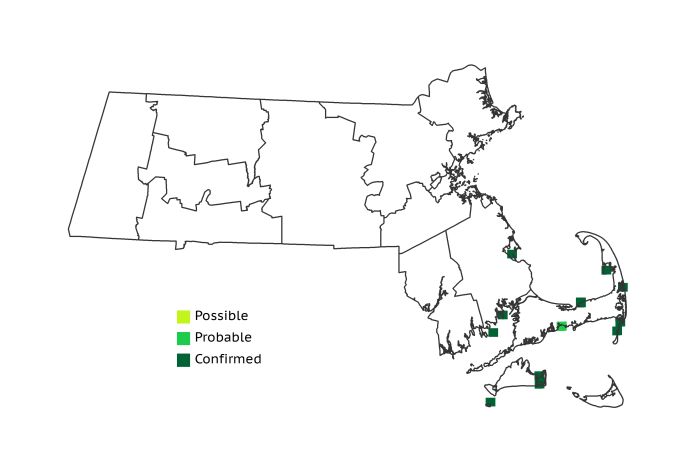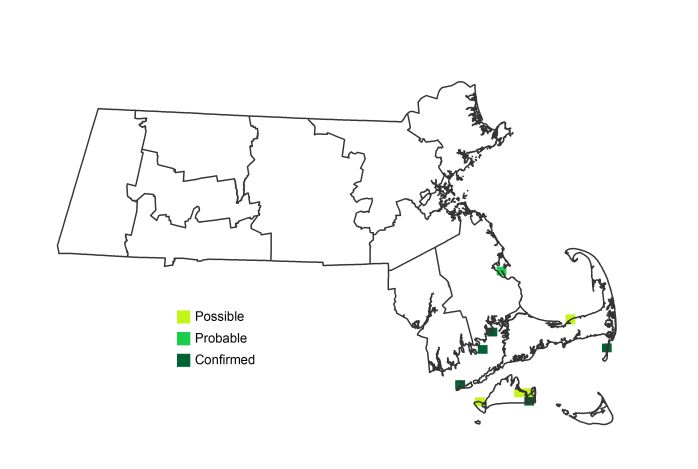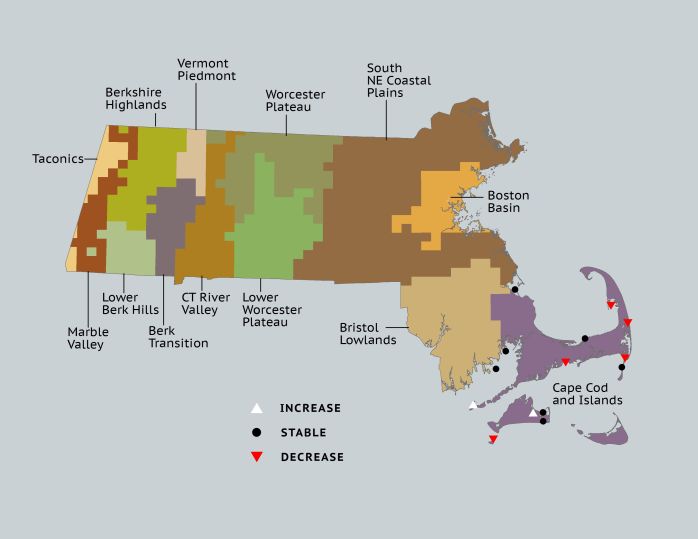Find a Bird
Roseate Tern
Sterna dougallii

Very local and strongly declining
Conservation action urgent
Endangered Species
“And to lose the chance to see…myriad terns flashing in the bright light of midday as they hover in a shifting maze above the beach—why, the loss is like the loss of a gallery of the masterpieces of the artists of old time.”—Theodore Roosevelt
As an Endangered Species in the Commonwealth of Massachusetts, the Roseate Tern has been justifiably receiving a lot of attention. Named for the pinkish wash that appears on its breast feathers during the breeding season, Roseate Terns are slender and graceful birds that make their living diving for fish. Roughly half of the entire North American population of this species breeds in the Bay State. An even larger proportion relies on favored Cape Cod localities like Monomoy and Nauset as staging areas during fall migration. Though they are protected and closely monitored, Roseate Terns’ future remains uncertain.
Historic Status
A single Roseate Tern shot by Thomas Nuttall on a beach in Chelsea at some point prior to 1839 was at the time considered to be an accidental visitor to the state. It was no accident in 1846, however, when the species set up a breeding colony in Beverly Harbor and another in Ipswich in 1869. By the 1870s, the species had become locally common along the coast, but unfortunately its attempts to establish permanent summer residency were met with gunfire. Plume hunters working for the millinery trade reduced the Massachusetts population to about 2,000 pairs in by the 1890s. Legal protection brought about in the early twentieth century helped the species rebound in the middle decades of that era, but on the species’ South American wintering grounds hunters were killing them for sustenance in the 1960s, contributing to yet another decline.
Atlas 1 Distribution
Although the majority of the Roseate Terns breeding in the state during Atlas 1 were in the Cape and Islands ecoregion, most of these birds resided in just two blocks in the Bristol/Narragansett Lowlands. Specifically, Bird Island in Marion hosted the majority of known breeding pairs in the state at the time. Although Roseates were no longer hunted for their elegant plumes, beach development, increasing recreational use of beaches, and an exploding gull population continued to make the full recovery of the Roseate Tern in Massachusetts an uphill battle. Many sites around Cape Cod and the Islands, including Monomoy and Martha’s Vineyard, hosted at least some breeding Roseate Terns, but during Atlas 1 most of their eggs were in the Bird Island basket.
Atlas 2 Distribution and Change
Observers found Roseate Terns in 10 blocks, 2 fewer blocks than Atlas 1, and not surprisingly all were along the southeastern coast. Several blocks on the outer Cape were abandoned, although two new blocks were added to the count. See the note below for a more thorough discussion of the trends of Roseate Tern.
Atlas 1 Map

Atlas 2 Map

Atlas Change Map

Ecoregion Data
Atlas 1 | Atlas 2 | Change | ||||||
Ecoregion | # Blocks | % Blocks | % of Range | # Blocks | % Blocks | % of Range | Change in # Blocks | Change in % Blocks |
Taconic Mountains | 0 | 0.0 | 0.0 | 0 | 0.0 | 0.0 | 0 | 0.0 |
Marble Valleys/Housatonic Valley | 0 | 0.0 | 0.0 | 0 | 0.0 | 0.0 | 0 | 0.0 |
Berkshire Highlands | 0 | 0.0 | 0.0 | 0 | 0.0 | 0.0 | 0 | 0.0 |
Lower Berkshire Hills | 0 | 0.0 | 0.0 | 0 | 0.0 | 0.0 | 0 | 0.0 |
Vermont Piedmont | 0 | 0.0 | 0.0 | 0 | 0.0 | 0.0 | 0 | 0.0 |
Berkshire Transition | 0 | 0.0 | 0.0 | 0 | 0.0 | 0.0 | 0 | 0.0 |
Connecticut River Valley | 0 | 0.0 | 0.0 | 0 | 0.0 | 0.0 | 0 | 0.0 |
Worcester Plateau | 0 | 0.0 | 0.0 | 0 | 0.0 | 0.0 | 0 | 0.0 |
Lower Worcester Plateau | 0 | 0.0 | 0.0 | 0 | 0.0 | 0.0 | 0 | 0.0 |
S. New England Coastal Plains and Hills | 0 | 0.0 | 0.0 | 0 | 0.0 | 0.0 | 0 | 0.0 |
Boston Basin | 0 | 0.0 | 0.0 | 0 | 0.0 | 0.0 | 0 | 0.0 |
Bristol and Narragansett Lowlands | 2 | 1.9 | 16.7 | 2 | 1.8 | 20.0 | 0 | 0.0 |
Cape Cod and Islands | 10 | 7.4 | 83.3 | 8 | 5.6 | 80.0 | -3 | -2.5 |
Statewide Total | 12 | 1.2 | 100.0 | 10 | 1.0 | 100.0 | -3 | -0.4 |
Notes
As with most colonially breeding species the Atlas is not the best tool for assessing changes. Single colonies are easy to miss, and even if a colony is reduced by 90%, the species is still recorded as breeding in the block. Estimates from counting pairs or nests are far more precise than Atlas field methods. The Natural Heritage & Endangered Species Program of the Massachusetts Division of Fisheries and Wildlife maintains the official counts for this species and other beach nesting birds (see graph below of the number of Roseate Tern pairs since 1986). While there is notable fluctuation over time, numbers are strikingly low considering the state houses 2 of the 3 largest colonies in the eastern US. Maintaining this population has been accomplished with intense management at nesting sites that includes habitat restoration and maintenance, symbolic fencing, and a corps of docents to help educate beachgoers about the sensitivity of beach nesting birds to disturbance. Unfortunately, even though Roseate Terns have been given the best protection possible and have benefited from the measures undertaken by tern managers in the Northeast, their population continues to decline, likely due to problems during migration and on their wintering grounds. However, without the measures undertaken there is every reason to believe this species, would slide even faster downward.




